Leather is a stiff material and requires time for your feet to get comfortable. I’m sure you want to rock in your new pair of boots immediately, but trust me, you shouldn’t.
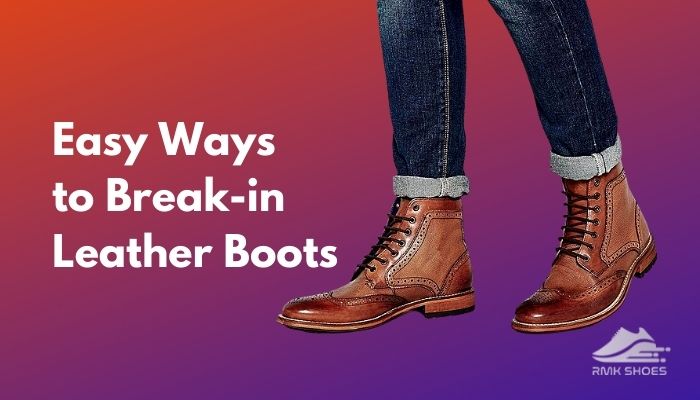
Let’s say you’ve invested in a perfect pair of boots; the excitement is over the roof. You go out immediately. What’s bound to happen? You’ll have blisters and pain in some regions of your feet. You must and should be wondering, what can you do?
Worry not! in this article. I got some game-changing hacks that’ll prevent you from having this bitter experience.
What Does Breaking-in Leather Boots Mean?
There are many ways to break-in leather boots. Different processes take different amounts of time. Some methods may take very little time, but they end up damaging your shoes as a result.
Then, some take a bit longer but are suitable for your shoes. Allowing your boots to soften up with time is like a natural process and does not harm your footwear. I prefer to take my time.
Related content you should read about how to break in Red Wing Boots?
Breaking-in Leather Boots (Methods)
There’re many ways to break-in leather boots. There’re lengthy methods and short methods; each has its pros and cons. After intensive research, I’ve provided the ones which will suit you just fine. Use these following methods, and your feet shall be thanking you.
Here are the methods to break-in leather boots properly.
Method-1: Wear Them Around The House
Your new boots will be all stiff and crunchy. You might want to avoid wearing them outside from the very beginning. A great way to start up the softening process would be to start wearing them around the house. You can start on a small dose.
You’ll experience some discomfort at the beginning, and that’s something you’ve to accept. With time you might want to increase the volume, and eventually, you’ll have your desired comfort. Be regular, and you’ll be there in no time.
To ensure maximum stretching and fasten the process, wear the fluffiest pair of sock you’ve or add an extra pair. Is there any other way to soften up your boots other than the comfort of your home? I don’t think so.
Some more guide on how to break in Doc Martens Overnight?
Method-2: Use Leather Conditioners
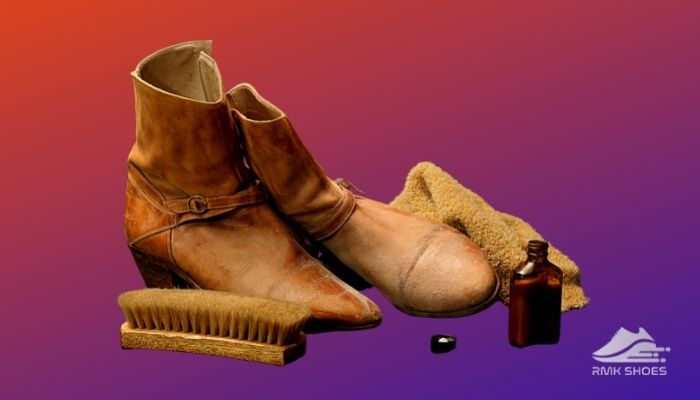
What happens when you apply moisturizer to your skin? It softens up, doesn’t it? Leather’s also a kind of skin that will soften up once you apply its moisturizer.
Conditioning your boot is also very important if you want to extend the longevity of your footwear. When you apply this particular item, it seeps through the stiff leather and softens the leather fibers, allowing you to easily stretch your boots.
This fastens the breaking-in process, yet protecting your shoes and feet. They’re also a great way to waterproof your boots. You might hear about many household items to be used as conditioners like lotion, coconut oil, etc.
But, just to be on the safe side, you might want to avoid them and stick to the leather conditioner.
Check out the easiest way to Break-In Cowboy Boots.
Method-3: Wear Them in The Morning
The weather’s cooler in the morning and your feet are at their actual size. What you can do is you can wear your boots and do some light walking for as long as you can. Not only won’t hurt your feet, but your shoes’ will get some stretching too; this also allows your footwear to mold around your feet.
You might want to avoid wearing your new shoes in the afternoon. Your feet get more extensive and bulkier due to the weather’s warmness and sweat at that time of the day. Apply this process for about two weeks and see the result for yourself.
Method-4: Warp Your Feet With Band-Aid
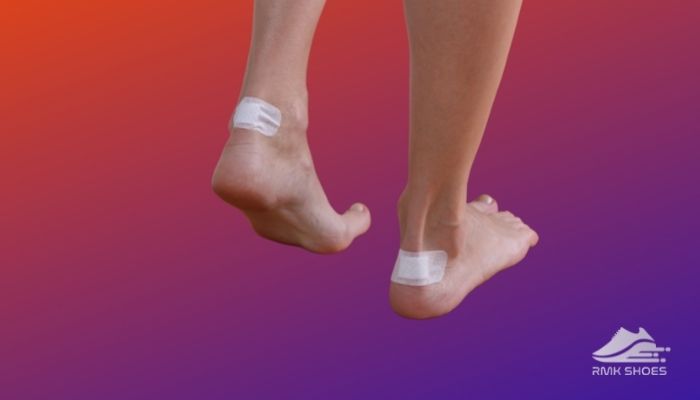
It’s always better to be on the safe side, isn’t it? How do the blisters form? They form due to the friction between the inner part of your shoe and your feet. Some areas are more prone to blisters than others, like the foot’s backside and the foot’s ball.
Ever thought of completely covering up the troubled areas? That’s right. You can cover up your troubled areas with band-aids designed specially for protecting your feet against new shoes. You can wrap them around the heel, toe, and ankle area. They’re readily available as well.
You can also invest in some good quality blister pads, as the name suggests they too are designed for the same purpose.
But before that, you check out how to Walk In Cowboy Boots.
Method-5: Try Bending And Twisting The Boots
Leather boots are stiff as they pass through numerous chemical treatments, making the leather fibers relatively inflexible. Gently bend and twist your shoes after you’ve worn them while they remain warm to loosen up the leather fibers.
Gently twisting and bending allow your boots to soften up in the troubled areas. All you have to do is make sure it is not too hard in your action. Being too hard might overstretch the fibers and crack the skin. Keeping yourself calm is the key to success in this particular process.
Method-6: Try To Ease Into Them
You’ll be making a big mistake if you’re planning to wear your new boots all day long. Your arch will have a hard time, and that’s something you don’t want. You’ll experience something similar to standing in a rung of the ladder.
Your job requires you to kneel quite often and cause the bottom set of hooks to infiltrate a nasty bite like experience. How do you prevent it? All you have to do is skip the first set of pins while lacing.
Method-7: Give Them A Breathing Space
I know the temptation of wearing your new pair of boots is too hard to handle. The thought of wandering out with your new boots on (always) is something that might come back to bite you later.
Your feet exude moisture while your boots soak them up. This moisture takes more than a night to evaporate entirely. Giving your shoes a day or two in between wears shall allow them to dry thoroughly and show them that much-needed break.
If you follow this procedure throughout the foreseeable future, you’ll experience the least amount of foot stink too.
Method-8: Keep A Back-Up
Your new boots may be quite comfortable at home, but it might not be the case after a certain amount of time outside. Your arches will need rest, so you shouldn’t have faith in your new boots for, let’s say a 12-hour haul.
As mentioned earlier, your feet remain at their proper size in the morning, so it’s better you wear your new boots first, in the morning for 2-3 hours and then revert to your old ones. Keep a pair of extra boots at your workplace or in your car’s trunk.
Personally, it’s one of my least favorite methods, but if you can follow this through until you get past your break-in period, then you should congratulate yourself!
Method-9: Use Shoe Stretcher
Your boots feel right for all parts, except one! The wide areas. It’s to get yourself a shoe stretcher. It looks pretty much like a shoe tree except with a crank to increase the feet’ width.
How does it work? You’ll just have to insert it into the boot, crank it open and leave it there for 7-8 hours. You’ll obtain maximum efficiency if you’re able to use it in combination with a leather conditioner.
Method-10: Go To A Bootmaker
Let’s say you’re one of those people who like things to go as fast as possible. In this case, the idea of breaking-in your boot may not be your cup of tea. Well, don’t worry! You can go to a cobbler for assistance.
They possess tools specialized in stretching your boots. Using the tools, they’d be able to expand your shoes in areas you need and add padding to an arch or insole. You just have to invest a bit more money and give them a few days to complete the process.
Things To Avoid While Breaking-in
I’m sure you want the best for your boots to ensure that you’ve known what might cause them irreparable damage.
Specific methods circling the internet may seem perfect but trust me, they aren’t. To avoid any accident, I came up with the following ways you should avoid it.
Here are the methods to avoid while breaking-in leather boots.
Avoid Heating Them
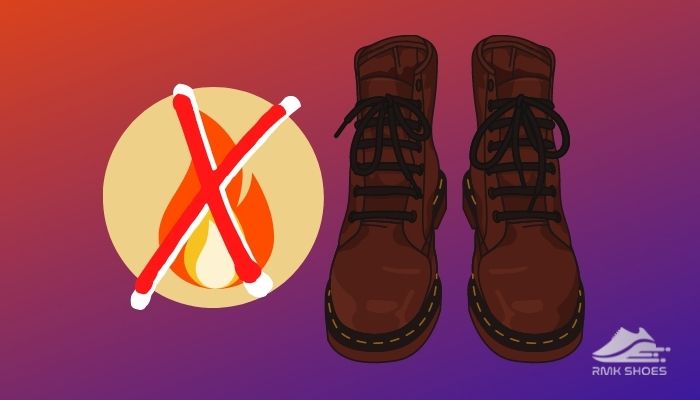
I’m sure you’ve heard the idea of softening up your boots via heating in an oven or by using a hairdryer. While heat does soften your boots and fasten the break-in process, there’s a big drawback.
Heat tends to make leather crack. What’s the point of cracking your expensive leather boots, even before you get to wear them? So, watch out!
Don’t Submerge In Water
Another factor is avoiding water treatment. Many water-based break-in tips are circling the internet like fully submerging them, partially submerging them, or even soaking them. However, leather can withstand some degree of moisture, its ultimately a bad idea for your boots.
Plus, water dries out your boots too.
My Personal Experience
I played for my high school soccer team and got this majestic Adidas Predator-X from South Korea. Of course, I bought the leather variant as they tend to have higher durability. As usual, it was tough the first few weeks, and then I eventually got past the break-in period. The problem started in the rainy season.
My boots completely soaked up water as much as they could, and they’d feel like they’d become ten times heavier, and I had difficulties playing. You know, what’s the worst of them all? It was when my boots wholly dried out. They felt like they shrunk a lot, and I’d struggled a lot to put them on.
After an epic brawl, I’d manage to put them on, and then another problem would arise. I felt as if the boots were squeezing my feet; this entire hassle would come to an end after almost a week. I hope you got my point!
Check out our separate post on how to Care For Cowboy Boots.
Factors To Consider Before Purchasing Leather Boots.
Some might say buy half a size small or one size small, the boots will eventually loosen up, and you’ll be alright. You end up listening and buy a pair only to see that nothing’s happening as the shoes are too small.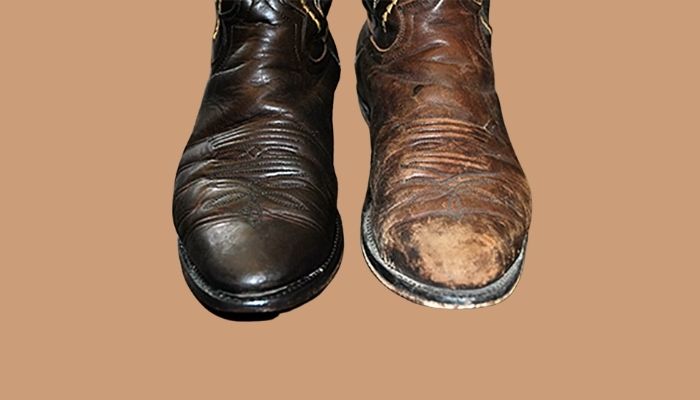
Trust me; this is something you should avoid as you can’t do anything about a pair of boots that’s too small. No amount of breaking-in will fix it if your toes are cramped or your foot’s width hangs over the footbed.
On the other hand, you’re getting a blister case for your feet if you’re buying a pair too big. What will happen is the friction between your feet and the inner part of the boot will result in nasty blisters plus, with your feet sliding around, you wouldn’t get past the break-in period either.
Be sure about your exact size before you plan to purchase online. The best thing would be to go on buying in person.
Common Questions People Ask
Should new leather boots feel tight?
No, your heel will always slip a little in properly fitted new leather boots. The slippage should disappear when you complete the breaking-in of your new boots.
Now for the most critical part, your entire foot should get a “tight feeling” in the beginning except for your heel.
How should you know if your boots are too small?
The definitive signs of the too-small boot are foot cramping or falling asleep while walking. Your toes will be prone to blisters as well. Properly fitted shoes should have adequate space to move your toes freely.
Do leather boots shrink or stretch?
Your boots will stretch up to a certain extent to mold to your feet when you buy your proper size. They won’t stretch 6-7 inches, and if you try hard, you may end up causing irreparable damage to them.
Once your boots get exposed to the right amount of water, they’ll undoubtedly stretch, but once they’re completely dried, they’ll shrink if you don’t wear them during the drying period.
Should you oil new boots?
No, factory-fresh boots have a good dose of conditioning and waterproofing in the leather, which should save your efforts to oil your shoes right away.
However, when the time does come, towel dry your boots and leave overnight at room temperature to let them dry thoroughly.
Conclusion
The thought of sliding into your new pair of leather boots could be quite enticing, and it’s natural, but for the betterment of your feet as well as your shoes, you’ve to be patient.
When you invest the right amount in a pair of leather boots, you must allow them to complete the breaking-in correctly. I suggest you don’t fast track anything as that may cause irreparable damage to your precious footwear.
Hopefully, through our guide, your job of softening your boots has become a whole lot easier. Do leave a comment and let us know about your experience.
Here at RMKShoes, I would love to hear from you, and with that, I wish you all the very best. Cheers.



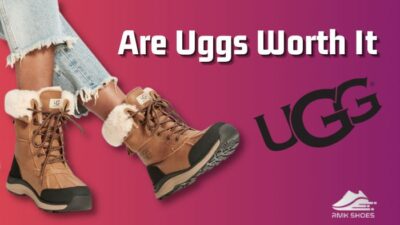

Thanks allot of information I never knew